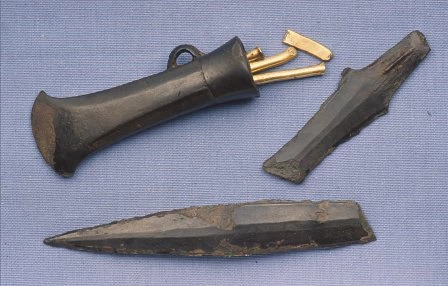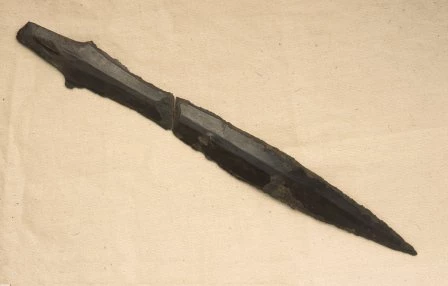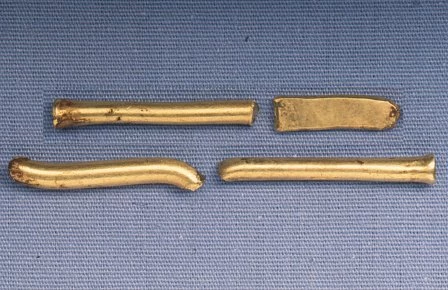3,000 year old Irish gold from North Wales
The hoard of Bronze Age artefacts recovered by metal detectorists near Wrexham.
The bronze knife, found in two fragments. The edges of the blade were heavily notched, perhaps suggesting it had been used for some time before burial.
The bronze axe, the socket of which contained the fragments of two or more gold bracelets.
The fragments of bracelets, probably made from Irish gold.
In 2002 a number of Bronze Age items were discovered near Wrexham, North Wales. Amoung the finds were a bronze knife, an axe head, and four fragments of gold bracelets. All were made between 1000-800BC and show links between Wales and Ireland during the Bronze Age.
The knife is of a type used throughout southern England and Ireland, and its shape mirrors much larger swords that were in use at this time. However, it is the first of its kind to be found in Wales.
The bronze axe head has a socket at one end, to which a wooden handle would have been attached, as well as a loop through which leather or twine would have been threaded to keep them together. It appears, however, that the axe head was buried without its handle since four fragments of gold bracelets were found stuffed into the socket. These valued finds include two terminals (end pieces) of a bracelet type most commonly used in Ireland, and are probably made of Irish gold.
These artefacts would probably have belonged to a person of considerable social standing since few people at this time would have had access to Irish gold and such finely worked tools. Quite why their owner decided to part with them will never be known for certain, although it is likely that they were buried as an offering to the gods.
The discovery adds valuable detail to our understanding of life in Wales 3,000 years ago. A time when leaders dressed to impress by wearing gold bracelets and hair ornaments, and a person's role within society was broadcast by the tools and weapons worn, the appearance of the horse they rode and the quality of a feast hosted.
Though most people in Wales were settled farmers and herders at this time, finds like the hoard from Wrexham show us that these small communities were part of large trading networks that linked Wales with Ireland. Evidence that our ancestors had more on their minds than food, farming and survival.
These items form part of the collections of Wrexham County Borough Museum.



